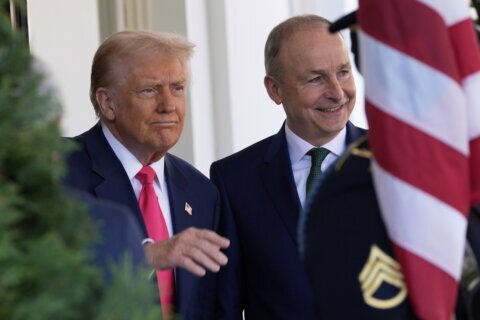FRANKFURT, Germany (AP) — With inflation subsiding, the European Central Bank cut interest rates again on Thursday to prop up tepid growth with lower borrowing costs for companies and home buyers. The U.S. Federal Reserve likely won’t be far behind in joining the rate-cutting process.
The bank’s rate-setting council lowered the deposit rate from 3.75% to 3.5% at a meeting at its skyscraper headquarters in Frankfurt.
It was the second rate cut as the bank starts to withdraw some of the swift rate increases it imposed to snuff out a burst of double-digit inflation that broke out after Russia cut off most natural gas supplies over its invasion of Ukraine.
But experts don’t expect a rapid series of rate cuts from either the ECB or the Fed central bank to anywhere near the rock-bottom levels from before the 2020 outbreak of the COVID-19 pandemic. They say the ECB will tiptoe, rather than slash, and might cut rates only one more time this year. Inflation’s down with the help of lower oil prices.
Inflation in the 20 countries that use the euro currency fell to 2.2% in August, not far from the ECB’s 2% target, down from 10.6% at its peak in October, 2022.
At her post-decision news conference, bank President Christine Lagarde said recent data had confirmed “our confidence that we are heading towards our target in a timely manner.” Asked about the next meeting on Oct. 17, she said, “I’m not giving you any commitment of any kind as far as that date is concerned.”
But she steered clear of any guidance on further cuts. She said the bank would make rate decisions on a meeting by meeting basis depending on incoming information about the economy and was “not pre-committing to a particular rate path.”
Policy makers must keep an eye on simmering inflation among services companies and rising wages as workers push to make up for purchasing power lost to the outburst of inflation that followed the end of the pandemic.
The ECB cut once in June and then hit pause in July before going on summer break in August. The rate-setting council led by President Christine Lagarde has to juggle concerns about a disappointing outlook for growth against – which argues for cuts – against the need to make sure inflation is going to reach the bank’s 2% target and stay there – which would support keeping rates higher for a bit longer.
Consumer prices spiked after Russian cut off most natural gas shipments to Europe over its February, 2022 invasion of Ukraine, sending utility bills higher. The rebound from the pandemic also led to bottlenecks in supplies of parts and raw materials, further boosting inflation that then spread more broadly to services, a broad category that includes medical care, personal services such as haircuts, restaurants, hotels and entertainment.
The ECB and the Fed responded with swift rate rises, the ECB bringing its benchmark rate to a record high of 4%, since cut in June to 3.75%.
The central bank’s benchmark rate strongly influences what private-sector banks pay to borrow – and through that rates across the rest of the economy. Higher rates cool inflation by making it more expensive to borrow and buy things, holding back price rises. But high rates can slow growth, and that worry is coming into focus.
Higher rates in Europe and the U.S. have meant increased mortgage costs for home buyers, and higher payments for people who run credit card balances or buy cars on credit. But they have been a boon to savers and retirees who like interest income and are getting visible returns on their bank holdings or money market accounts after years of zero returns.
The Fed is also expected to make a first cut in its benchmark rate at its Sept. 17-18 meeting from a 23-year high of 5:25%-5.5%. Consumer prices rose 2.5% in August from a year earlier, down from 2.9% in July. It was the fifth straight annual drop in inflation. Core inflation excluding volatile fuel and food – which can be a better guide – was higher at 3.2%.
“The long-awaited Fed easing cycle is upon us,” said Brian Coulton, chief economist at Fitch Ratings, but the Fed rate-setters “will be cautious after the inflation challenges of the past few years. The pace of rate cuts will be gentle and monetary easing won’t do much to boost growth next year.”
Europe growth has been sluggish, at 0.3% in the second quarter of this year and a roughly 1.0% annual rate based on performance in the first half. That follows more than a year of near-zero stagnation. Hopes for a more robust pickup have been dampened by recent indicators of business and consumer sentiment, and by a stream of bad news from the eurozone’s biggest economy, Germany.
Germany contracted by 0.1% in the second quarter and its outlook remains gloomy amid a global slowdown in manufacturing. On top of that come long-term factors such as an ageing population, shortage of skilled workers, lagging implementation of digital technology, and excessive bureaucracy that slows down business creation and expansion. Major employer Volkswagen has dropped its no-layoffs pledge that was to run through 2029 as it seeks to cut costs, and has warned it may need to close one or more factories in Germany amid weaker demand for its new electric vehicles in Europe and in China.
Copyright © 2025 The Associated Press. All rights reserved. This material may not be published, broadcast, written or redistributed.







